
Pierres précieuses bleues : une liste de 33 pierres précieuses bleues
 De l'azurite au saphir en passant par le zircon bleu, les pierres précieuses bleues attirent l'attention comme aucune autre. Selon des études internationales, le bleu est la couleur la plus populaire. C'est aussi la couleur la plus rare de la nature !
De l'azurite au saphir en passant par le zircon bleu, les pierres précieuses bleues attirent l'attention comme aucune autre. Selon des études internationales, le bleu est la couleur la plus populaire. C'est aussi la couleur la plus rare de la nature !
Les gemmes bleues symbolisent la tranquillité, la communication honnête et la dévotion. Pierres de guérison , elles sont réputées pour accroître la patience, apaiser l'anxiété et favoriser des relations saines et de confiance.
Pendant des siècles, les pigments bleus étaient chers, réservés aux nobles et aux riches. De nombreuses religions le considéraient comme une couleur sacrée, des ornements des sacrifices humains mayas à la Vierge Marie chrétienne. Le premier pigment synthétique fut le « bleu égyptien », créé vers 2500 av. J.-C. par, à notre grande surprise, les anciens Égyptiens.
Aujourd’hui, nous disposons d’une abondance d’articles bleus, y compris une quantité surprenante de pierres et de cristaux bleus, allant du bleu bébé au bleu nuit profond et partout entre les deux.

Quelles pierres précieuses sont bleues ?
Agate bleue
Apatite
Azurite
Bleu vert
Bénitoïte
Calcédoine bleue
Chrysocolle
Diamant bleu
Dumortiérite
Fluorite bleue
Grandidiérite
Œil de faucon
Hémimorphite
Iolite
Jadéite bleue
Jéréméjévite
Cyanite
Labradorite
Lapis lazuli
Larimar
Pierre de lune
Opale bleue
Perles bleues
Pietersite
Saphir bleu
Shattuckite
Sodalite
Spinelle bleu
Tanzanite
Topaze bleue
Tourmaline bleue
Turquoise
Zircon bleu
Passons maintenant en revue chacune de ces gemmes bleues !
Liste des pierres précieuses bleues
Retrouvez ci-dessous le nom et la signification de chaque pierre précieuse bleue par ordre alphabétique :
Agate bleue

L'agate est un sous-groupe de calcédoine comprenant des variétés translucides, rubanées ou à motifs. Le type bleu le plus populaire est l'agate dentelle bleue , une variété relativement rare présentant des volutes ou des bandes blanches, bleu ciel à lilas, et bleu vif.
Les perles ou cabochons d'agate en dentelle bleue sont populaires et ces pierres précieuses bleu clair sont la gemme officielle de l'État du Nebraska, aux États-Unis.
Comme toutes les gemmes bleues de cette liste, l'agate bleue peut être utilisée comme pierre de chakra de la gorge, vous permettant de mieux comprendre et d'exprimer votre moi le plus vrai.
Apatite
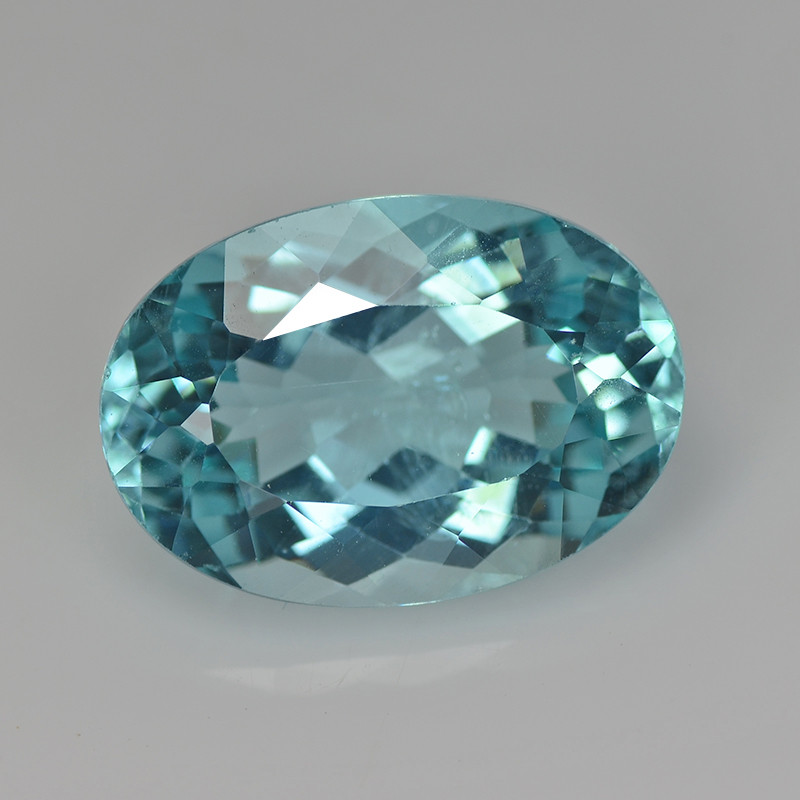
L'apatite désigne un groupe de pierres précieuses ou une pierre précieuse individuelle de ce groupe. Les couleurs de cette pierre sont variées, mais les bijoux en apatite les plus connus sont bleu caraïbe ou bleu-vert fluo, rappelant la tourmaline Paraïba.
D'un point de vue minéralogique, l'apatite est la norme pour 5 sur l' échelle de dureté de Mohs .
Azurite

L'azurite est une pierre bleue d'une richesse remarquable, dont l'importance historique en tant que pigment bleu est remarquable. Un exemple notable est la peinture de la Renaissance de Raphaël , La Vierge à l'Enfant en majesté avec les saints .
La teinte bleue de la pierre peut varier entre pâle, vive ou foncée. Cependant, la couleur de l'azurite vire souvent au vert lorsqu'elle se transforme en malachite . De nombreuses gemmes sont des combinaisons des deux (azur-malachite), avec la possibilité de sculptures sphériques imitant la Terre.
Bleu vert
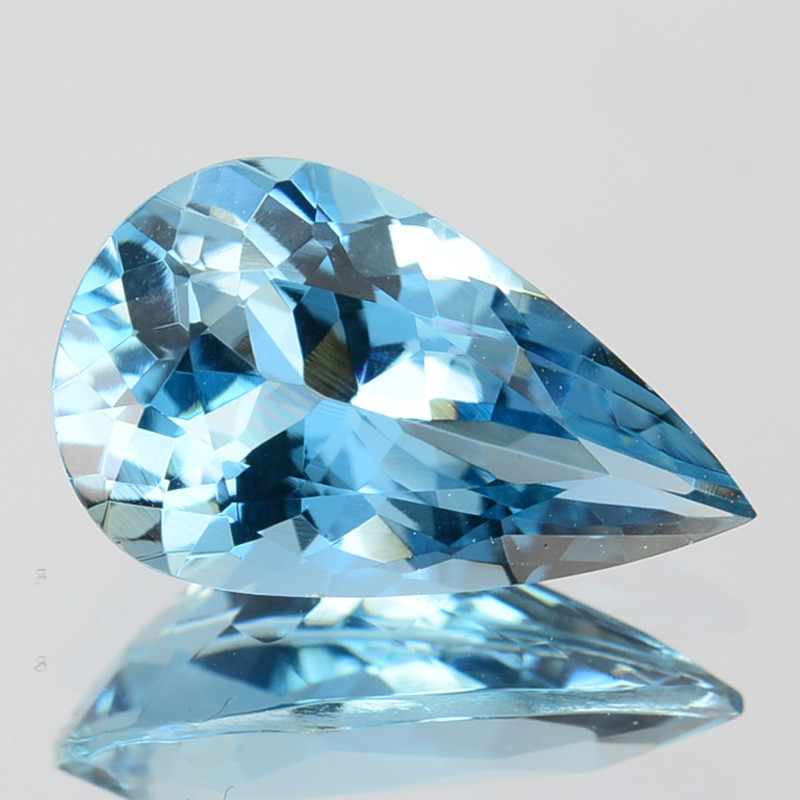
La première pierre de naissance de notre liste, pour les bébés de mars , est la légendaire aigue-marine, dont l'origine remonte (selon les documents historiques) à environ 480-300 av. J.-C. Cette variété de béryl est connue pour sa gamme de bleus et de bleus-verts doux à profonds. La plupart sont bleu-vert clair.
Quelle couleur d'aigue-marine est la plus chère ? Les aigues-marines les plus précieuses ont une couleur bleu intense et pur. Les traitements thermiques sont courants pour atténuer les tons verts.
Quelles sont les pierres bleues les plus rares ? L'une d'elles est…
Bénitoïte
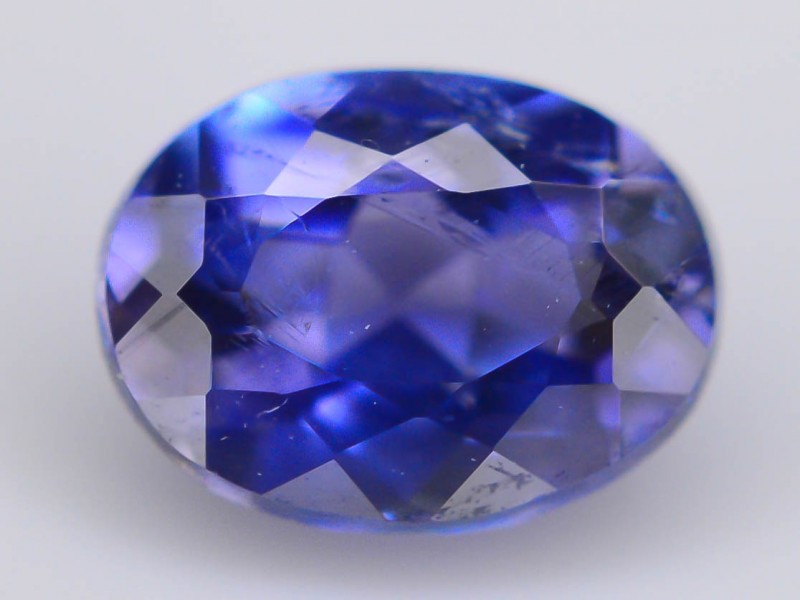
La benitoite n'est pas seulement l'une des pierres précieuses les plus bleues, elle est aussi l'une des plus rares. Pourquoi est-elle si rare ? Cette gemme bleu saphir, bleu-violet ou incolore ne se trouve sous forme de cristaux de qualité gemme que dans une mine californienne (San Benito), produisant environ 300 carats par an.
L'éclat ardent de la bénitoïte (dispersion) dépasse également celui du diamant (à un prix inférieur), et l'origine définitive de la couleur bleue de la bénitoïte reste un mystère, malgré de nombreuses études.
Calcédoine bleue

La calcédoine englobe un vaste groupe de quartz microcristallins. Hormis l'agate, les variétés bleues comprennent :
Calcédoine bleue : Les variétés simplement étiquetées « calcédoine » sont souvent translucides et de couleur unie dans des tons bleus, blancs ou bleu-violet.
Aquaprase : La variété la plus récente découverte en 2014, cette pierre est bleu-vert et vendue sous le nom d'AquapraseTM lorsqu'elle est naturelle, non traitée et distribuée par Avant Chordia
Calcédoine Chrysocolle (Gemme Silice) : La variété de calcédoine la plus précieuse, cette variété a une coloration bleu-vert vif et/ou bleue provenant de minuscules inclusions de chrysocolle.
Jaspe : Bien que rares, les variétés de jaspe bleu sont parfois le jaspe océanique, le jaspe kambaba et le jaspe impérial.
Les sources nomment souvent leurs calcédoines bleues spécifiques, comme « bleu Mojave » de Californie, « bleu africain » de Namibie ou « bleu houx » de l'Oregon.
La calcédoine bleue est-elle rare ? Les pièces de qualité gemme sont rares. Le bleu profond, naturel et uniforme est la couleur de calcédoine la plus rare.
Chrysocolle

Quelle est cette pierre bleu clair qui ressemble à de la turquoise ? Vous pensez peut-être à la chrysocolle, un carbonate de cuivre à la coloration bleue à verte, souvent strié de noir (ce qui le distingue de la turquoise).
Bien que tendre, la chrysocolle est un minerai de cuivre important et produit de belles pierres précieuses lorsqu'elle est mélangée à d'autres pierres.
Un exemple important est la pierre d'Eilat, qui contient de la chrysocolle, de la turquoise et de la malachite (entre autres minéraux). C'est la pierre nationale d'Israël et on la surnomme la « pierre du roi Salomon ».
Diamant bleu
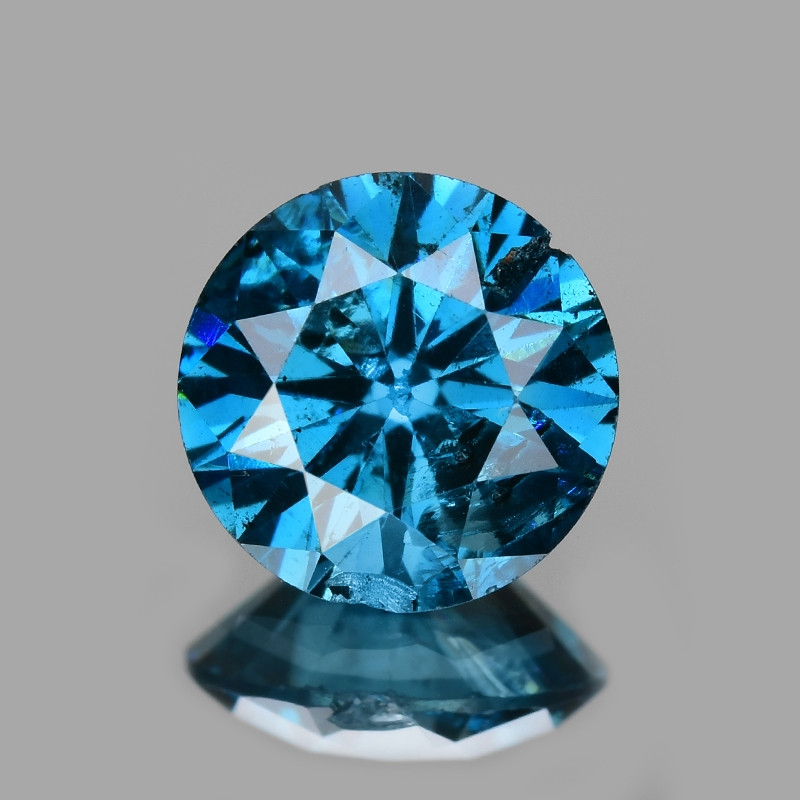
Le diamant, joyau des pierres précieuses, est précédé de nombreuses distinctions. Mais les diamants bleus existent-ils vraiment ? Oui, ils existent à l'état naturel. Bien qu'ils ne soient pas la couleur de diamant la plus rare, certains des diamants les plus chers au monde sont bleus :
Hope Diamond : 3ème diamant le plus cher, évalué jusqu'à 350 millions de dollars américains (plus de 7 millions de dollars par carat) en mars 2023
Oppenheimer Blue Diamond : 7e diamant le plus cher, vendu pour 57,5 millions de dollars américains (plus de 4 millions de dollars par carat) en 2016
Blue Moon of Josephine Diamond : 10e diamant le plus cher, vendu pour 48,4 millions de dollars américains (environ 4 millions de dollars par carat) en novembre 2015
Bien sûr, les diamants bleus sont toujours des diamants, ce qui signifie qu'ils sont également des pierres précieuses , des pierres de naissance d'avril et la pierre précieuse traditionnelle pour les 10e, 60e et 75e anniversaires de mariage , en plus d'être la substance la plus dure au monde.
Dumortiérite
 Sur la photo ci-dessus : Dumortiérite dans du quartz
Sur la photo ci-dessus : Dumortiérite dans du quartz
La dumortiérite est un borosilicate généralement bleu, bleu-vert ou bleu-violet, mais elle peut aussi être rose ou rouge. « Pierre denim bleue » est le surnom donné à la dumortiérite d'un bleu profond.
Pierre précieuse moins connue, elle est mieux connue pour être ce qui donne au « quartz dumortiérite » sa couleur bleue, car ce type de quartz présente diverses inclusions de dumortiérite.
Parfois appelé « Quartz bleu de Bahia » ou « Quartz bleu de lune », le quartz dumortiérite présente une grande variété d'aspect. Certains spécimens sont transparents avec des aiguilles de dumortiérite bleues (similaire au quartz rutile), tandis que d'autres présentent des inclusions rappelant des récifs coralliens.
La cause de la couleur bleue de la dumortiérite n’est pas entièrement connue.
Les premières théories attribuaient le bleu au transfert de charge du fer ferreux (Fe2+) et du titane (Ti4+). Des analyses chimiques ultérieures ont montré que la dumortiérite incolore contenait une teneur en magnésium bien plus élevée. Certains scientifiques pensent donc que cet excès de magnésium se lie au titane, ce qui fait qu'il ne reste plus assez de titane pour se lier au fer et donner la couleur bleue.
Fluorite bleue
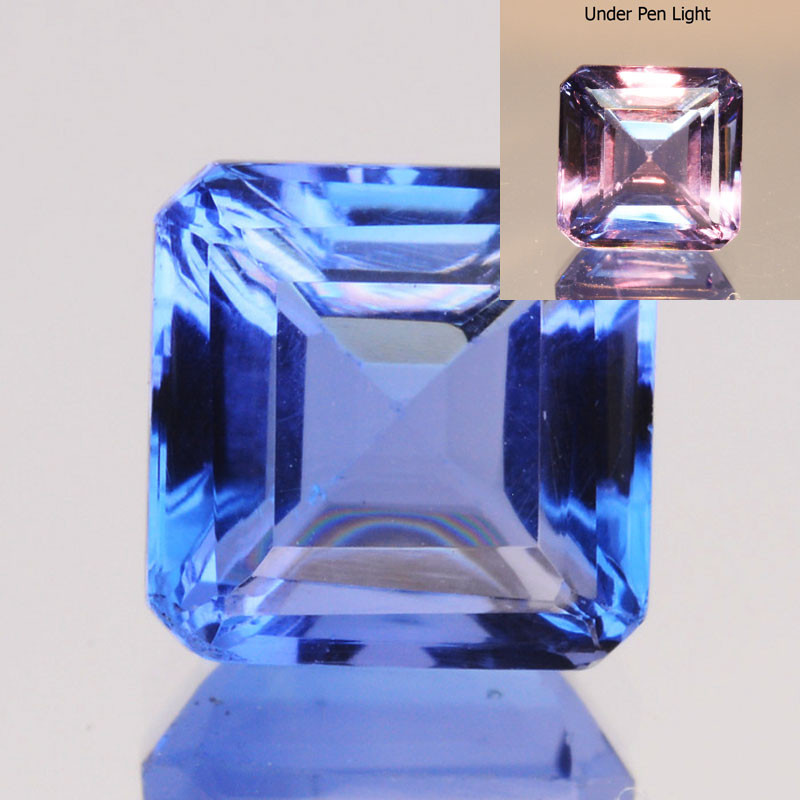
La fluorite est connue pour sa plus grande variété de couleurs parmi tous les minéraux, mais une couleur rare et recherchée est le bleu. La fluorite bleue peut être zonée, changeante de couleur (passant du bleu ou du sarcelle au lilas ou au vert selon la luminosité), ou d'un type particulier appelé « Blue John ».
La « pierre Blue John » ou « spath du Derbyshire » est un type rare de fluorite que l'on trouve exclusivement dans les grottes de Treak Cliff et de Blue John, dans le Derbyshire, en Angleterre. Elle présente des bandes bleu-violet et jaune.
Grandidiérite
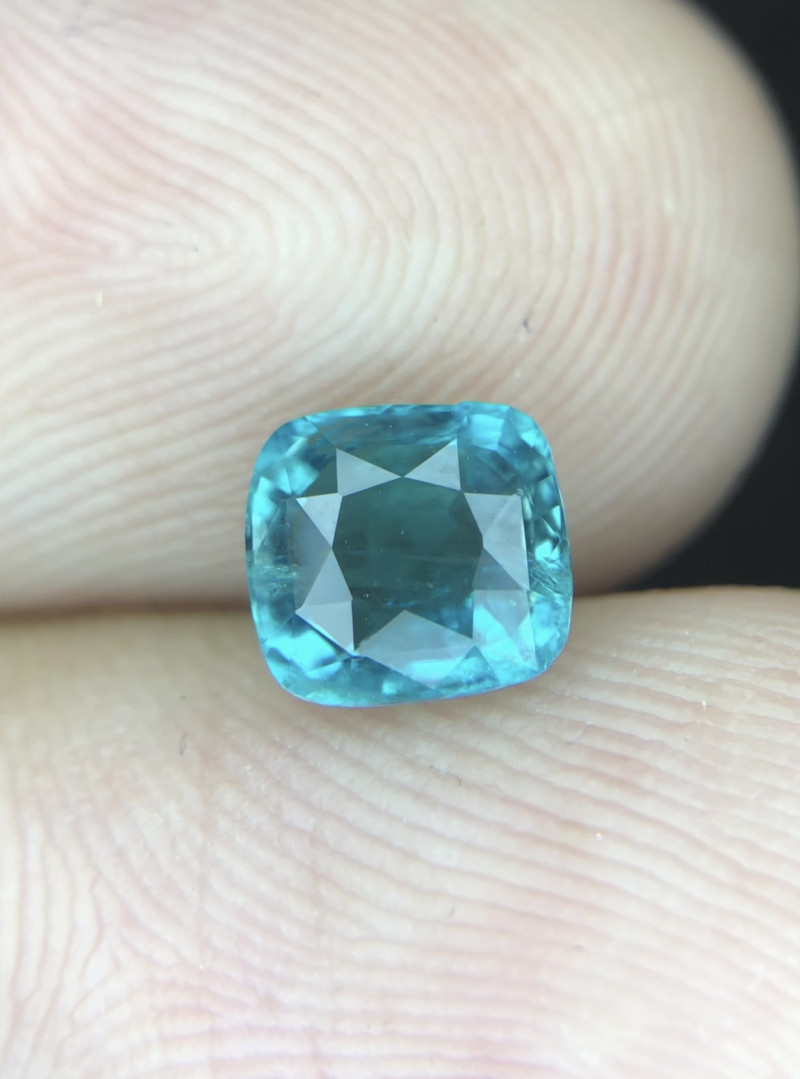
Comme la bénitoïte, la grandidiérite est l'une des pierres précieuses les plus rares au monde. La grandidiérite est une gemme bleu-aigue-marine à vert d'eau, dont la teneur en fer est plus élevée, ce qui lui confère une coloration bleue plus prononcée.
La pierre n'existe que dans des nuances de bleu, bleu-vert ou vert. Cependant, elle présente également un fort pléochroïsme (couleurs différentes selon l'angle de vue) en vert foncé, bleu-vert foncé et incolore ou jaune clair.
En termes de prix, la première grandidiérite transparente facettée a atteint environ 172 000 $ le carat, mais les pierres facettées de bonne qualité coûtent généralement entre 20 000 $ et 26 000 $ le carat. Les cabochons sont beaucoup plus abordables.
Œil de faucon

L'œil de faucon est une pierre précieuse bleu titane à bleu-vert qui est techniquement un pseudomorphe de roche et de quartz, car il commence comme crocidolite (amiante bleu) qui se transforme en quartz mais reste fibreux.
Les spécimens tachés par le fer lors de leur formation deviennent des pierres d'œil-de-tigre brun doré. C'est pourquoi l'œil-de-faucon est parfois appelé « œil-de-tigre bleu ».
La structure fibreuse confère à l'œil de faucon une chatoyance simple, un effet optique similaire à l'effet « œil de chat », mais au lieu d'un seul rayon de lumière réfléchi, il y a plusieurs traînées de lumière.
Hémimorphite
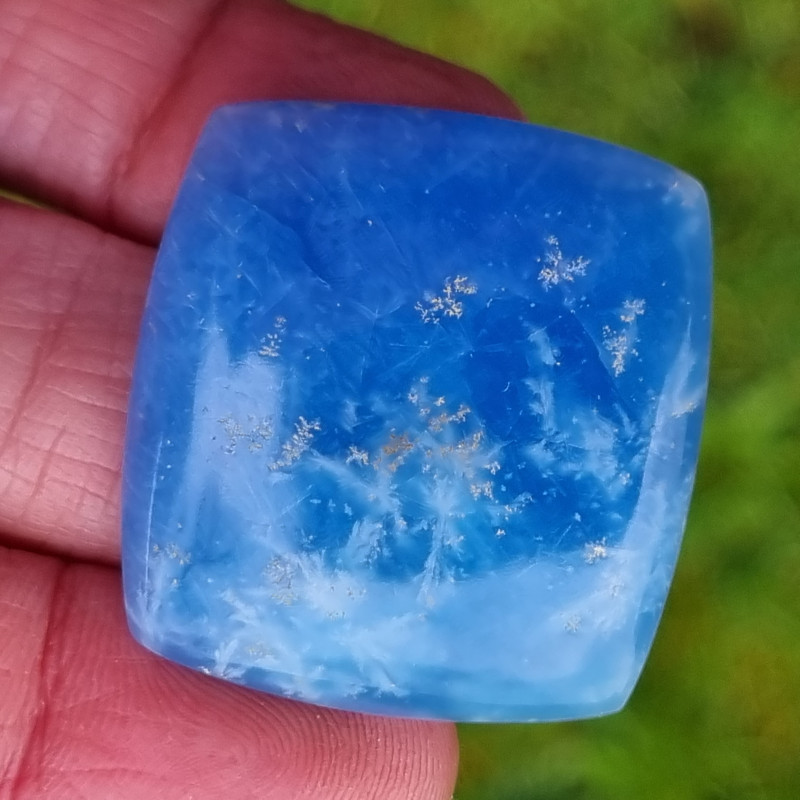
L'hémimorphite est un minéral rare, généralement blanc, gris ou brun, mais ses formes bleu œuf de merle ou bleu vif sont prisées des collectionneurs. Outre sa couleur, l'hémimorphite possède d'autres propriétés particulières.
Qu'est-ce qui rend l'hémimorphite si particulière ? Ses terminaisons (les extrémités verticales du cristal). Au lieu d'être globalement identiques aux deux extrémités, les cristaux d'hémimorphite sont émoussés et présentent généralement une face à une extrémité, tandis que l'autre a une forme pyramidale plus pointue. C'est pourquoi son nom vient du grec « hémi », qui signifie « moitié », et « morph », qui signifie « forme ».
La plupart des spécimens d'hémimorphite présentent des bandes ou des marbrures bleues et blanches. Les hémimorphites bleues étant particulièrement rares, certains vendeurs peu scrupuleux teignent l'aragonite en bleu pour la faire passer pour de l'hémimorphite bleue.
De plus, l’hémimorphite est souvent confondue avec la smithsonite , un autre minerai de zinc d’apparence similaire.
Iolite
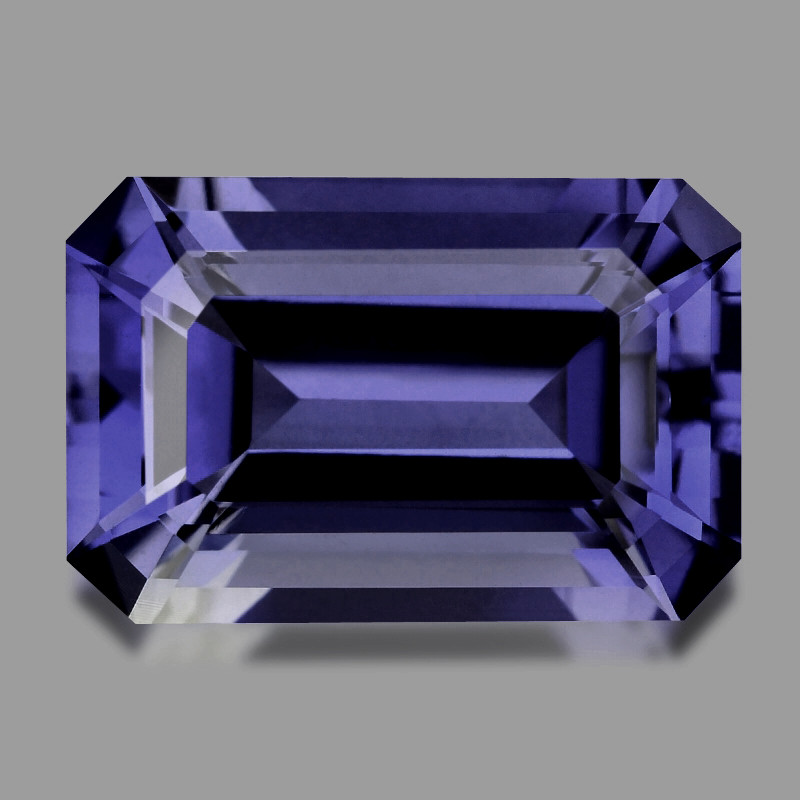
Bien que son nom vienne du terme grec ios , signifiant « violet », l'iolite est en réalité une variété de cordiérite bleu-violet. Les couleurs d'iolite les plus prisées sont un bleu légèrement violet et un bleu pur, dus à des impuretés de fer. Parmi ses autres caractéristiques notables, on peut citer son fort trichroïsme (trois couleurs pléochroïques) et sa capacité à présenter parfois une chatoyance ou une aventurescence.
L'origine la plus célèbre de l'iolite est la légende selon laquelle les Vikings auraient utilisé l'iolite pour naviguer en mer, en utilisant des tranches pour trouver le soleil (et donc leur emplacement) les jours nuageux.
À l'époque moderne, l'iolite est une pierre du zodiaque pour le Sagittaire et la pierre précieuse du 21e anniversaire de mariage.
Jadéite bleue
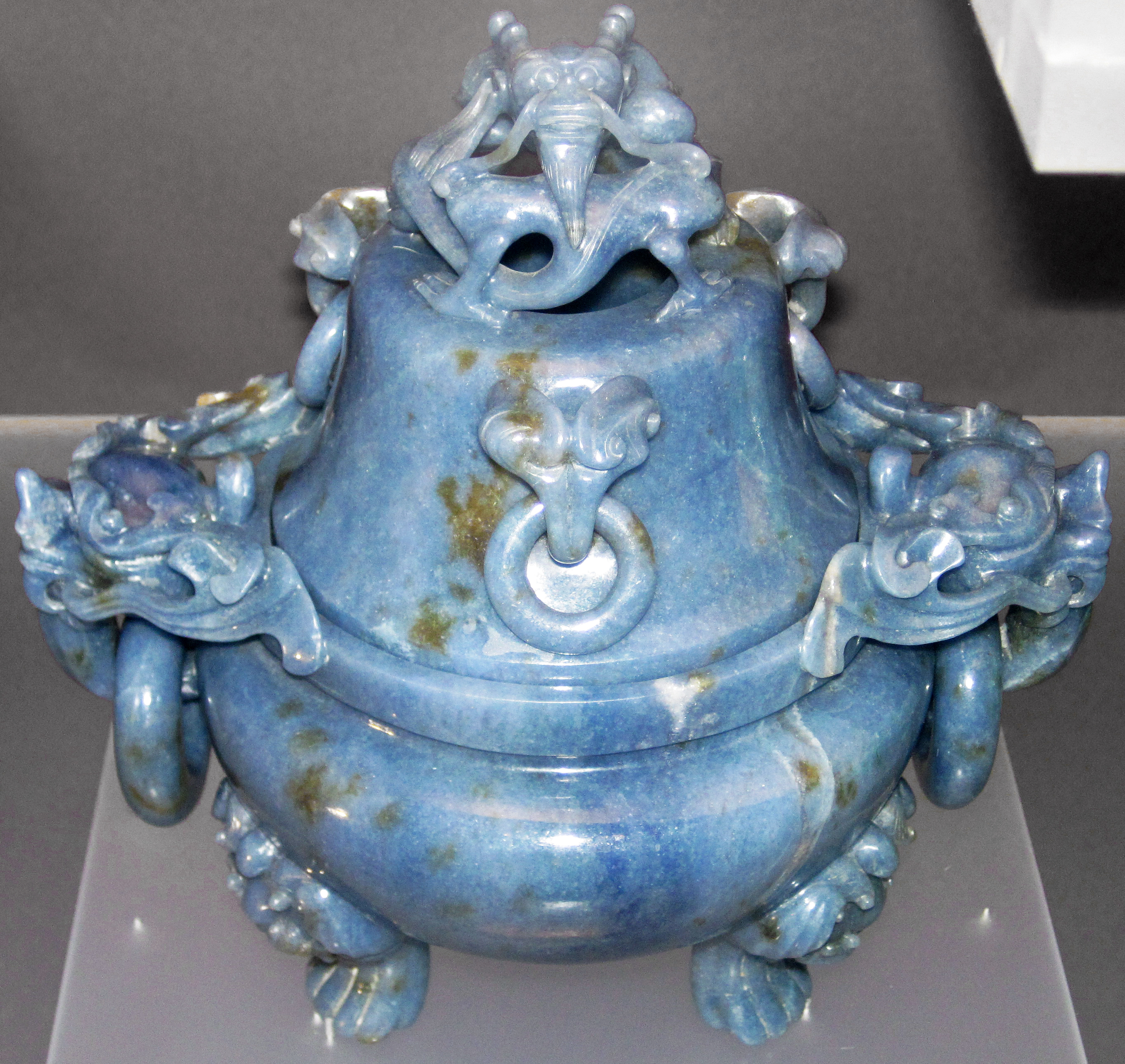 Photo ci-dessus : Brûleur d'encens chinois en jadéite bleue de la dynastie Qing | Crédit photo : James St. John, CC-BY-SA-2.0
Photo ci-dessus : Brûleur d'encens chinois en jadéite bleue de la dynastie Qing | Crédit photo : James St. John, CC-BY-SA-2.0
La jadéite est l'une des deux pierres précieuses (avec la néphrite) appelées « jade ». La néphrite et la jadéite sont toutes deux plus connues comme pierres vertes , mais la jadéite se décline dans une variété de couleurs plus vives et plus variées. La couleur la plus rare de la jadéite, également absente de la néphrite, est le bleu.
Qu'est-ce que la jadéite bleue ? C'est une jadéite naturelle et rare, généralement d'un bleu laiteux, mais qui peut aussi être bleu moyen ou bleu-vert pâle.
Un type célèbre est la « jadéite bleue olmèque ». Cette jadéite bleue translucide et aqueuse (colorée par le titane et le fer) était vénérée par les Olmèques, première civilisation mésoaméricaine qui existait entre 1600 et 400 av. J.-C. Pour les Olmèques, la jadéite bleue symbolisait le renouveau, la vie et la croissance, et les anciens Mayas adoptèrent cette vénération.
Les Mayas ont gardé les sources de jadéite jusqu'à leur disparition, et ce n'est que dans les années 1970 et au début des années 2000 que la jadéite bleue olmèque a été redécouverte au Guatemala.
Jéréméjévite
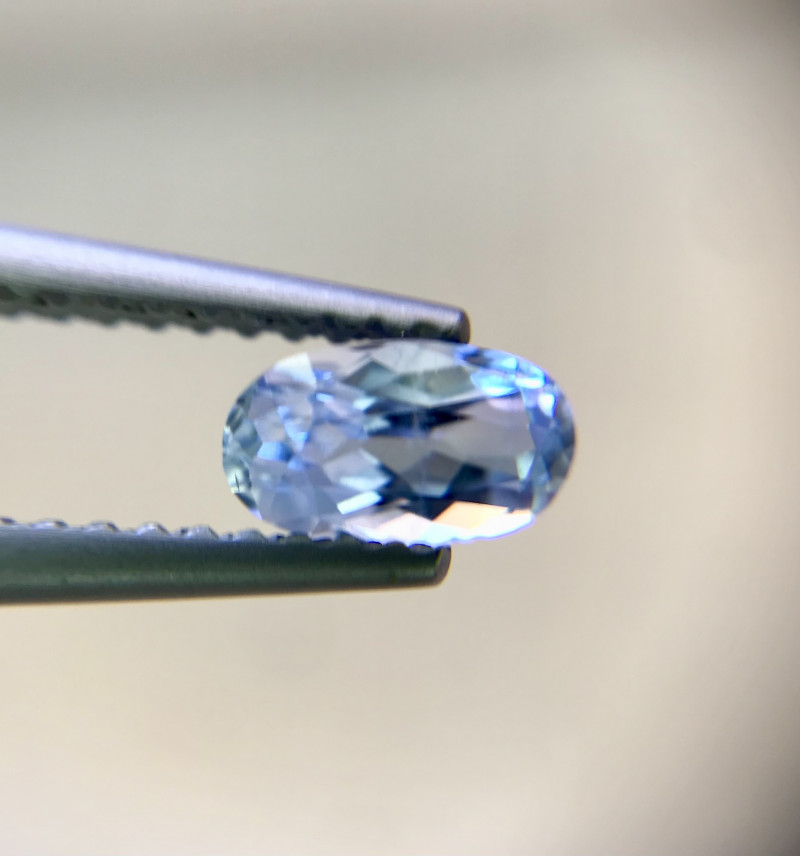
La jéréméjévite (prononcé yer-ah-mi-YAI-vite) est une pierre précieuse rare de couleur pâle, très prisée des collectionneurs pour ses couleurs allant du bleu pâle au bleu-vert. Découverte en Russie en 1883, les premiers cristaux facettés (bleu-vert) ont été découverts en Namibie en 1973.
Quantifiant la rareté de la jéréméjévite, de nombreuses listes la classent parmi leurs 10 pierres précieuses les plus rares. Les pierres facettées sont extrêmement rares, surtout au-dessus d'un carat. Même les petits cristaux (non taillés) coûtent environ 60 $.
En dehors du bleu, les couleurs de la jéréméjévite comprennent également l'incolore, le jaune clair ou doré, le brun jaunâtre, le vert clair et le violet.
Cyanite
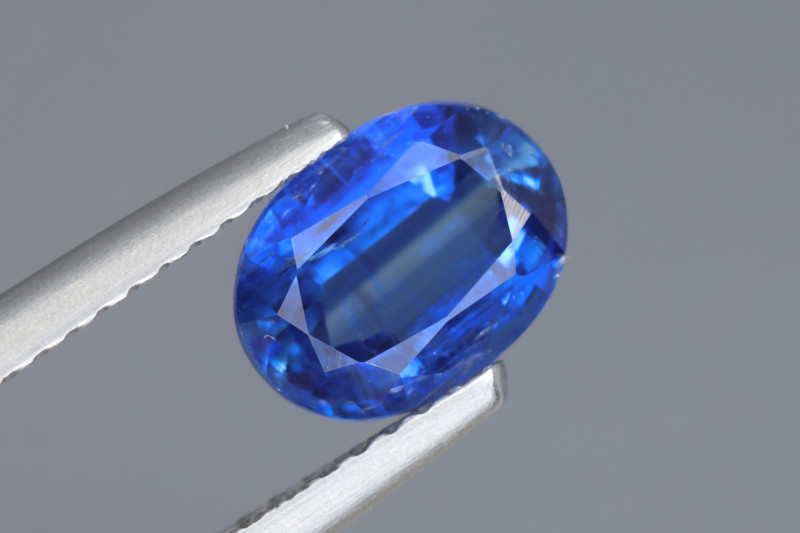
Minéral relativement commun mais pierre précieuse rare, la cyanite est particulièrement populaire (et la plus courante) en bleu. Les bleus de la cyanite varient du pâle au foncé, et de nombreux spécimens présentent des rayures blanches et bleues, souvent avec un bleu profond striant le centre du cristal.
D'autres termes pour désigner la cyanite sont « cyanite » et « disthène ». Les utilisations industrielles de la cyanite sont nombreuses. Les principales applications sont la fabrication de réfractaires thermiques (où sont fabriquées les céramiques) et de matériaux électroniques.
Spirituellement, la cyanite bleue est utilisée pour la protection, la force et la communication.
Labradorite
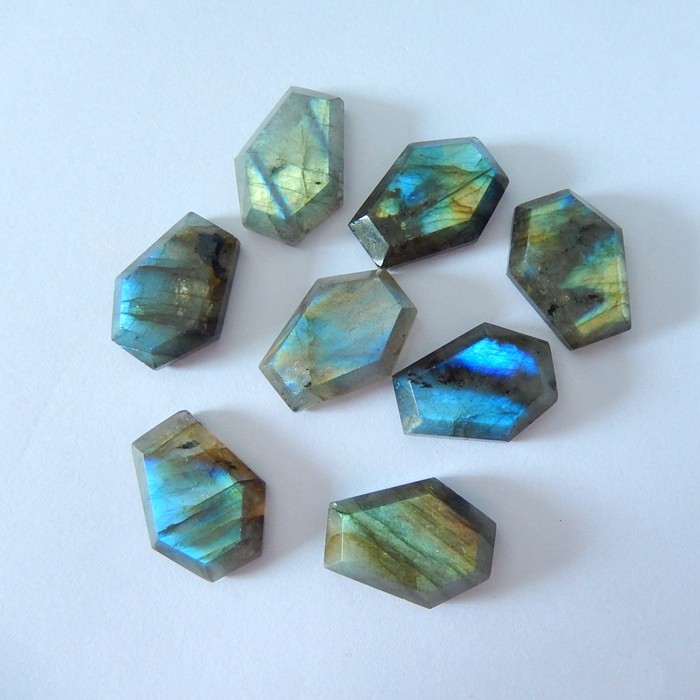
La labradorite est une variété de feldspath spectaculaire qui se distingue par sa labradorescence éponyme, un type d'irisation aux multiples reflets colorés. Les bleus vifs et les oranges sont les reflets les plus courants.
Une variété connue pour sa quasi-transparence et ses intenses reflets bleus est appelée « pierre de lune arc-en-ciel ». On peut également observer des reflets bleus, ainsi que toutes les autres couleurs de l'arc-en-ciel, dans la rare variété finlandaise de labradorite, la spectrolite .
Lapis lazuli

Le lapis-lazuli (ou lapis) est une roche d'un bleu roi profond, souvent parsemée d'inclusions de calcite blanche et de pyrite dorée. Le principal minéral présent est la lazurite (ou sa variété hauyne), une variété de sodalite d'un bleu outremer profond.
Cette pierre est le « bleu » originel, source des plus anciens pigments bleus connus, remontant à des peintures rupestres de l'Afghanistan actuel, vers 400-700 après J.-C. Pendant des siècles, seuls les Égyptiens de l'Antiquité savaient produire ce pigment bleu ; ils étaient d'ailleurs la seule culture antique à posséder un mot pour « bleu ».
Le pigment lapis-lazuli « outremer » gagna en popularité en Europe vers le XIIe siècle, mais coûtait plus cher que l'or. Devenu plus accessible, il devint un phénomène, notamment dans la peinture chrétienne de la Renaissance.
Aujourd'hui, le lapis-lazuli est la pierre de naissance du mois de septembre et la pierre précieuse traditionnelle du 9e anniversaire de mariage.
Larimar
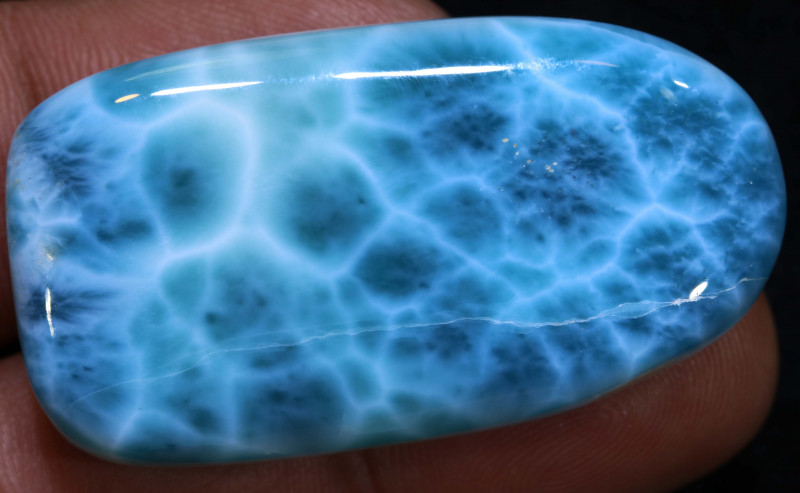
Parmi les pierres précieuses les plus rares, on trouve le larimar, une pierre vert d'eau à bleu clair aux motifs blancs et nuageux. On le trouve uniquement en République dominicaine. La couleur la plus populaire est le bleu ciel, mais la couleur la plus rare et la plus précieuse est un bleu profond appelé « bleu volcan ».
Presque tous les larimars présentent un motif, le plus beau étant bleu foncé avec des rubans blancs. Le plus courant est constitué de lignes blanches ou de taches de pectolite sur une base bleue.
Si vous vous demandez quel est le nom de la pierre précieuse bleu bébé , il se peut que ce soit du larimar, mais il se peut aussi que ce soit de la pierre de lune.
Pierre de lune

La pierre de lune est une variété de feldspath généralement translucide, disponible en plusieurs couleurs. Les plus belles et les plus précieuses présentent une base incolore, sans inclusions, et un éclat bleu moyen. Cet éclat, ou « flash », est appelé adularescence, donnant l'impression que la pierre brille de l'intérieur.
Compte tenu de leur valeur, les pierres de lune bleues sont-elles rares ? Si les pierres de lune de grande taille et de haute qualité, quelle que soit leur couleur, sont plutôt rares, les pierres de lune à reflets bleus dépassent rarement 15 à 20 carats. Attention : certains vendeurs malhonnêtes qualifient de « pierre de lune bleue » la calcédoine artificiellement teintée de bleu.
Les pierres de lune sont des pierres de naissance alternatives de juin et des talismans porte-bonheur du signe du Cancer .
Opale bleue
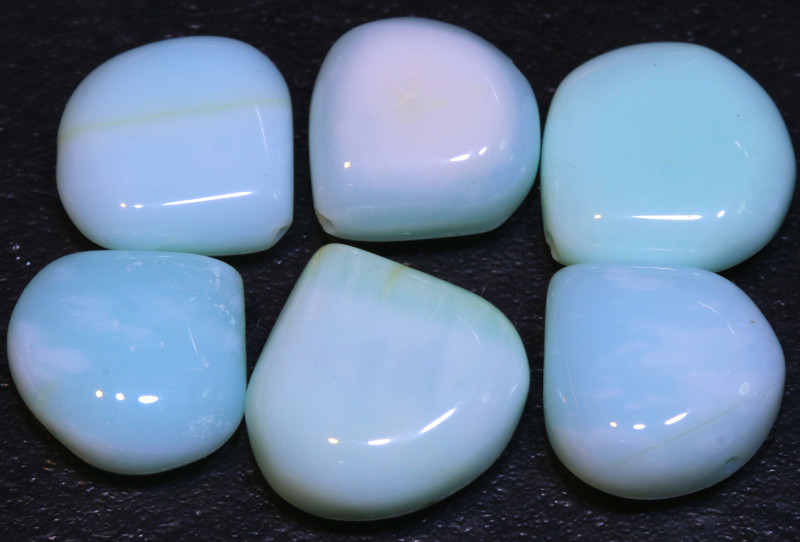
En plus d'être des pierres de naissance d'octobre et des minéraloïdes (pas des minéraux), les opales sont uniques et vastes dans leurs variétés.
Les deux principales catégories sont les opales communes (sans jeu de couleurs irisé) et les opales précieuses (avec jeu de couleurs). Les opales communes sont souvent moins recherchées, à l'exception de l' opale commune bleue .
Un exemple célèbre d'opale commune bleue très prisée est l' opale péruvienne , d'une douce couleur sarcelle, pierre nationale du Pérou. Les opales Owyhee, originaires de l'Oregon, présentent également des nuances de bleu clair à foncé atténuées.
Cela dit, les opales précieuses peuvent aussi être bleues. La couleur la plus précieuse, l'opale noire, peut parfois avoir un corps bleu foncé qui permet à son arc-en-ciel de s'exprimer pleinement.
Perles bleues
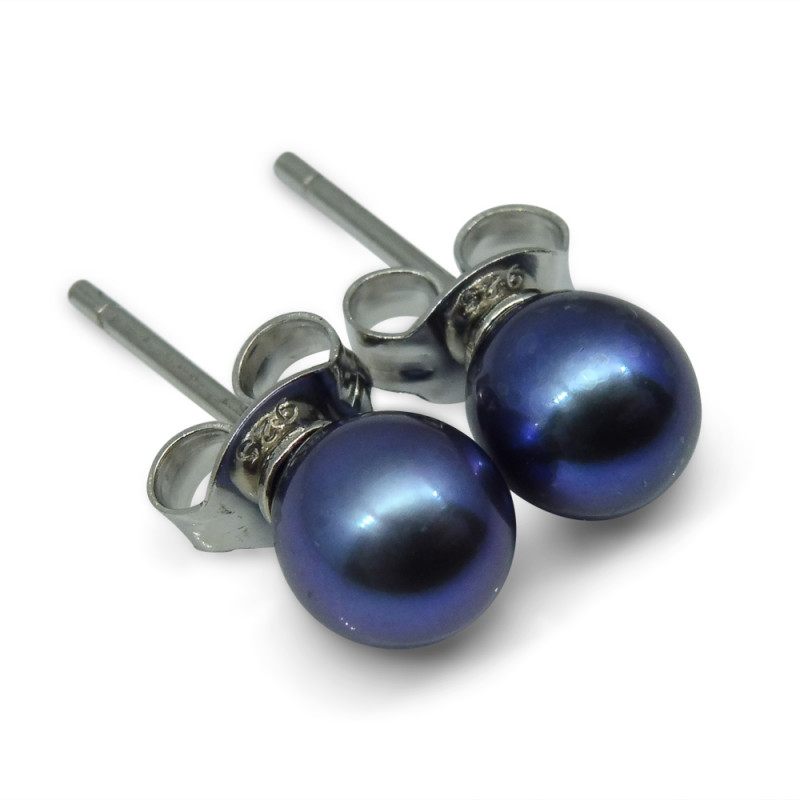
Cette pierre de naissance de juin est plus connue pour ses teintes ivoire, mais vous verrez rarement du bleu naturel dans des types de perles comme les perles d'Akoya, de Tahiti ou des mers du Sud.
Les bleus sont généralement nuancés, allant du bleu argenté (mer du Sud) au bleu ciel (Akoya) en passant par le bleu nuit (Tahiti). Les perles d'ormeau, à la forme unique, présentent également des reflets bleus irisés.
Outre leur caractère organique , les perles bleues sont très rares. Elles font partie, avec les perles dorées, des couleurs naturelles les plus rares.
Pietersite
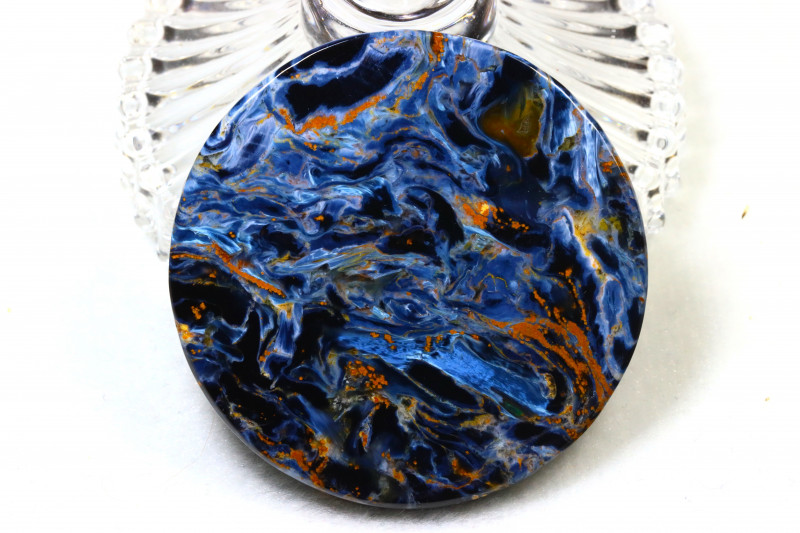
La piétersite est une pierre multicolore souvent appelée « œil d'aigle ». Cet agrégat de calcédoine à motifs contient du quartz cimentant des fragments d'œil de faucon et d'œil de tigre (généralement), créant un spectacle à dominante bleue, dorée et rouge.
Chaque piétersite présente un motif et une combinaison de couleurs uniques, le bleu et le brun étant les couleurs prédominantes. Comme ses homologues « œil », la piétersite présente une chatoyance simple. Découverte récemment en Namibie en 1962, elle est également présente.
"https://www.gemrockauctions.com/learn/technical-information-on-gemstones/blue-sapphires-what-makes-sapphires-blue"> Saphir bleu
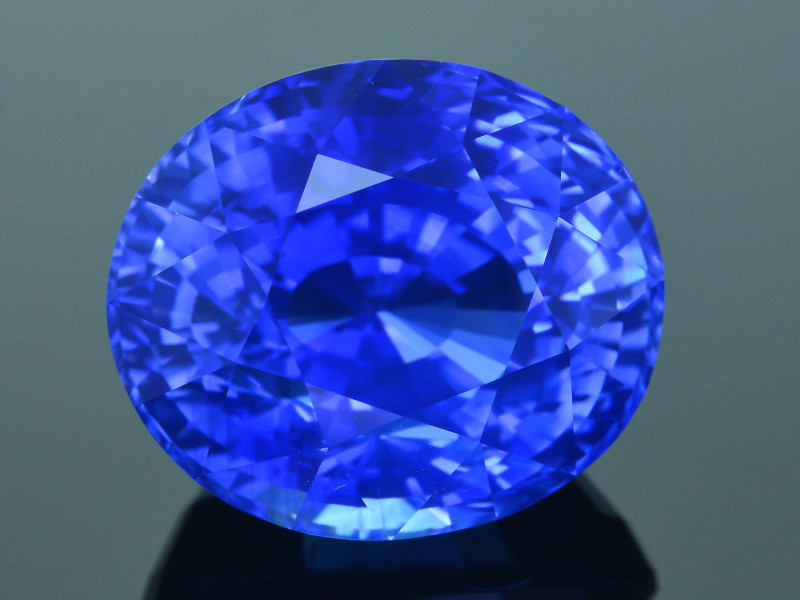
La pierre précieuse bleue la plus célèbre est sans doute le saphir , une variété de corindon reconnue comme LA pierre précieuse bleue royale de l'histoire. Bien que les saphirs existent dans toutes les couleurs sauf le rouge (qui correspond au rubis), les saphirs bleus sont les plus populaires et les plus précieux.
Les meilleurs saphirs bleus sont le bleu bleuet et le Cachemire, qui est également bleu bleuet mais velouté et provient exclusivement de l'Himalaya.
Autres types notables de saphir bleu :
Saphir étoilé : affiche une « étoile » de lumière réfléchie à rayons multiples ; la plupart sont noirs, roses ou bleus, le bleu de qualité supérieure étant celui qui a la plus grande valeur.
Saphir sirène ou paon : saphir bleu sarcelle avec un rapport 50-50 de bleu et de vert
Saphir changeant de couleur : passe généralement du bleu ou du violet à la lumière du jour au violet ou au violet rougeâtre sous l'effet de l'incandescence ; appelé à tort « alexandrite bleue »
Qu'ont les saphirs bleus de si particulier ? Outre leur histoire et leur diversité, les saphirs bleus sont des pierres durables, constituant la pierre centrale la plus courante des bagues de fiançailles aux États-Unis avant que les diamants ne deviennent la norme.
Shattuckite
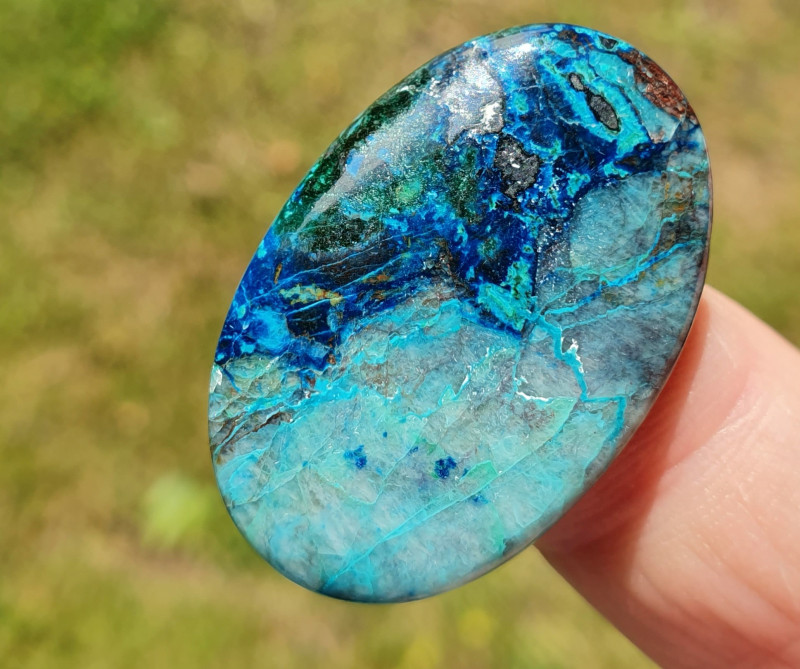 Sur la photo ci-dessus : Cabochon de shattuckite bleue avec azurite, malachite, chrysocolle et cuprite
Sur la photo ci-dessus : Cabochon de shattuckite bleue avec azurite, malachite, chrysocolle et cuprite
Nommée ainsi en référence à sa découverte à la mine Shattuck en Arizona, aux États-Unis, la shattuckite est une gemme de cuivre connue pour ses nuances vertes ou bleues, allant du bleu marine au bleu cobalt intense. Les spécimens provenant du Congo pourraient être appelés « Lunazul ».
Les spécimens de shattuckite sont généralement mélangés à d'autres pierres comme le quartz, la malachite, l'azurite ou la chrysocolle. La distinction entre chrysocolle et shattuckite est également difficile, nécessitant souvent une analyse professionnelle. De nombreux cabochons de shattuckite sont tachetés de différentes nuances de bleu, de vert, de gris ou de noir.
Sodalite

Vous vous demandez quelle pierre ressemble au lapis-lazuli ? Il s'agit probablement de la sodalite, une pierre abordable de couleur denim, bleu de Prusse ou bleu-violet, souvent ornée de motifs blancs et/ou bruns. En comparaison avec la sodalite et le lapis-lazuli, ce dernier est une roche (et non un minéral) et contient la lazurite, une variété de sodalite.
Techniquement, la « sodalite » est un groupe de minéraux. Certains minéraux de sodalite, comme l'hackmanite , sont ténébrescents, ce qui signifie qu'ils changent de couleur au soleil et reviennent à leur couleur d'origine dans l'obscurité.
Spinelle bleu
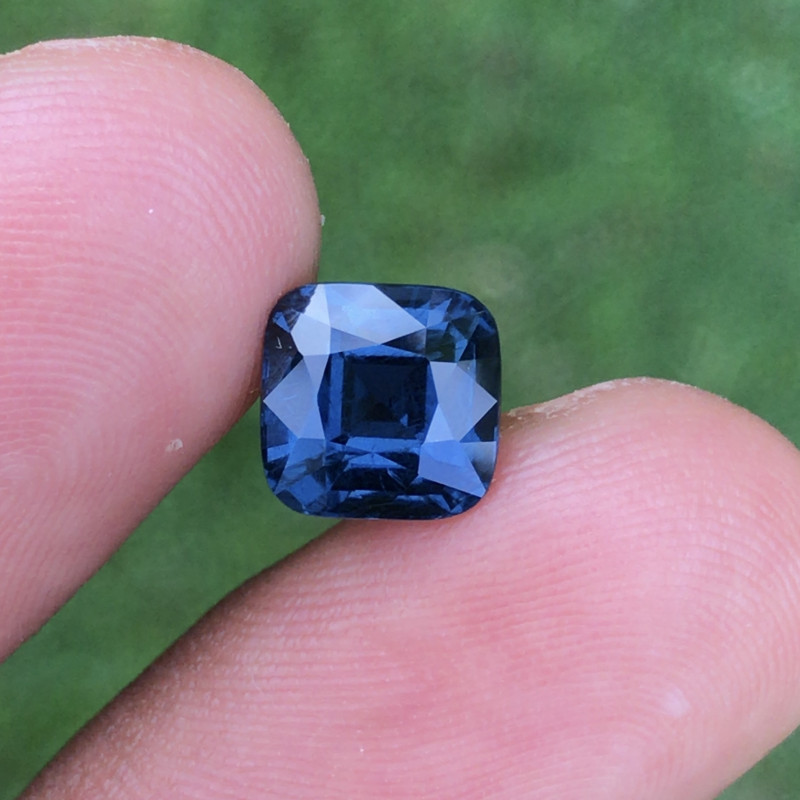
Dernière nouveauté parmi les pierres de naissance standardisées (ajoutée en août 2016), le spinelle se décline dans une multitude de couleurs vives. Historiquement confondu avec les précieux rubis et saphirs, il possède pourtant de nombreuses variétés de bleus remarquables :
Gahnospinel : Mélange bleu et bleu foncé de spinelle et de gahnite
Pléonast : Variété opaque bleu foncé, noire ou verte
Spinelle Alexandrite : Variété changeant de couleur, bleu-gris à la lumière du jour et violette sous incandescence ; Remarque : distincte de l'alexandrite
Les spinelles bleus de qualité supérieure sont du bleu cobalt, qui peut également être fabriqué sous forme de fusion à la flamme ou de matières synthétiques cultivées par flux.
Maintenant, quelle gemme est bleue et violette ?
Tanzanite

La tanzanite est une variété d'épidote bleue, violette ou bleu-violet que l'on trouve uniquement en Tanzanie. Cette gemme est déjà rare, mais les spécimens naturellement bleus sont extrêmement rares ; la plupart des tanzanites bleues ont donc été traitées thermiquement.
La tanzanite doit-elle être bleue ou violette ? Elle peut être l'une ou l'autre, mais son intense pléochroïsme signifie que de nombreuses tanzanites facettées seront bleues et violettes sous différents angles.
Comme le spinelle, la tanzanite est une pierre de naissance récemment ajoutée, mais pour décembre .
Topaze bleue
 Sur la photo ci-dessus : pierres précieuses de topaze bleue de Londres taillées sur mesure
Sur la photo ci-dessus : pierres précieuses de topaze bleue de Londres taillées sur mesure
La topaze bleue est une autre pierre de naissance hivernale de décembre ! Cette topaze est une alternative beaucoup plus abondante et abordable à la tanzanite ou au saphir bleu.
Il existe différentes nuances de topaze bleue à connaître, dont beaucoup sont traitées :
Bleu de Londres : Gris foncé ou bleu acier ; Généralement le plus cher ; Parfois naturel, généralement traité thermiquement
Bleu suisse (électrique) : bleu néon clair ; traité thermiquement
Bleu ciel : bleu plus pâle à bleu verdâtre ; souvent irradié ; alternative courante à l'aigue-marine
Topaze bleue fondue au centre : bleu moyen saturé ; résultat d'une diffusion et d'un traitement HPHT
Une autre variété créée avec des traitements est la topaze mystique , qui a un revêtement irisé de bleus, de violets et de verts.
Tourmaline bleue
 Sur la photo ci-dessus : tourmaline indicolite
Sur la photo ci-dessus : tourmaline indicolite
La tourmaline se compose de trois espèces principales : la schorl, la dravite et l’elbaïte. L’elbaïte est la plus précieuse, et deux d’entre elles sont bleues : l’indicolite et la tourmaline Paraïba .
L'indicolite présente une coloration bleu clair à foncé, bleu-vert ou bleu-vert due à des impuretés de fer. La tourmaline paraïba présente des nuances bleu néon, bleu-vert ou violet très vives dues à des impuretés de cuivre.
La tourmaline paraïba est plus rare, plus brillante et nettement plus précieuse que l'indicolite. Cependant, toutes deux restent des pierres de naissance d'octobre et des talismans de la Balance .
Turquoise
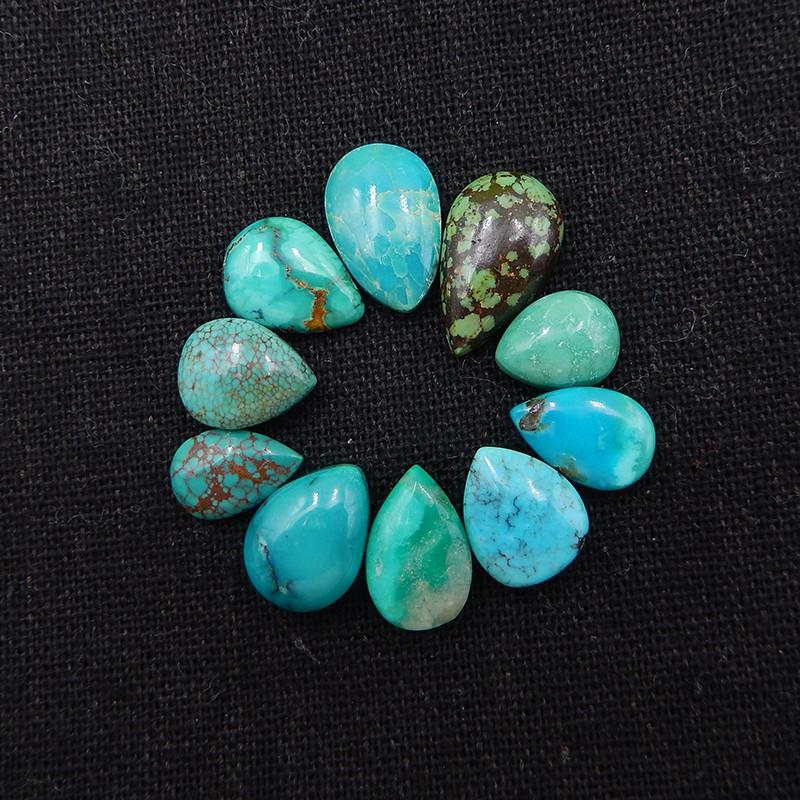
La turquoise est une pierre bleu-vert généralement opaque, souvent veinée de jaune ou de brun. Son nom vient du français « turquois » , qui signifie « turc », car les Européens se la procuraient par les voies commerciales turques.
Le mélange caractéristique de vert et de bleu a inspiré la couleur « turquoise ». Cependant, les turquoises peuvent varier du bleu vif au vert.
Attention : de nombreuses turquoises de qualité inférieure sont teintes ou stabilisées pour une meilleure couleur. D'autres pierres peuvent être vendues comme des imitations, notamment de la howlite ou de la magnésite teintées, deux pierres naturellement blanches présentant des motifs de veines similaires à ceux de la turquoise.
Zircon bleu

Pour couronner notre liste, le zircon bleu, une pierre naturelle souvent confondue avec la zircone cubique synthétique, est sous-estimé. Outre le fait qu'il s'agisse de la plus ancienne substance connue sur Terre, le zircon impressionne par sa dispersion supérieure à celle du diamant, pour un coût bien inférieur.
La couleur la plus populaire, le zircon bleu électrique, commémore les anniversaires de décembre et les 4 ans de mariage. Les zircons bleus peuvent être naturels, mais ils sont souvent traités thermiquement pour devenir bleus.
Du ciel à la mer, les options de pierres précieuses bleues sont abondantes !
La diversité des pierres précieuses bleues est immense. Avec des nuances, des niveaux de saturation et des prix variés, vous trouverez forcément la pierre bleue idéale pour vous !
Parcourez des centaines de pierres précieuses bleues chez Gem Rock Auctions aujourd'hui !
Rechercher le Gemstone Encyclopedia
Enchères associées
Articles Liés
Les émeraudes Gota De Aceite possèdent une particularité qui augmente leur valeur. Apprenez-en plus sur ce type d'émeraude rare et découvrez comment elle augmente sa valeur.
9th May 2018
Le jade est une pierre magnifique qui peut prendre de nombreuses couleurs, notamment le vert, l'orange ou le blanc. Apprenez à tester le jade pour vérifier son authenticité.
9th May 2018
La cornaline est une calcédoine célèbre pour ses couleurs orange vif. Découvrez sa signification, son histoire et ses propriétés dans ce guide pratique !
26th Feb 2021
Derniers articles
Les sculptures en ivoire de palmier, aussi appelé ivoire végétal, sont une alternative naturelle à l'ivoire d'éléphant. Elles sont obtenues de manière éthique à partir de la noix du palmier Phytelephas d'Amérique du Sud. Découvrez tout sur l'ivoire de palmier dans ce guide !
15th Jan 2026
Les pierres en forme de chrysanthème sont des merveilles naturelles présentant un motif floral en calcite blanche, en célestine ou en andalousite sur fond de calcaire ou de mudstone noir.
13th Jan 2026
La pierre de soleil à treillis arc-en-ciel est une variété de feldspath présentant trois magnifiques effets optiques dus à la présence de diverses inclusions. Son éclat irisé et ses motifs en treillis en font une gemme rare et recherchée par les collectionneurs !
12th Jan 2026
Catégories d'articles
How To's is where you will find helpful articles from gem Rock Auctions on how to cut gemstones, select gemstones and buy gemstones.
9 les articles





![PINK AMETHYST [ROSE DE FRANCE] ROUGH 33.00 CTS [F1155 ]](https://liveplatforms-production.b-cdn.net/tenants/gr/uploads/images/130000-134999/133183/133183_1254215926.jpg?width=480&aspect_ratio=1001%3A1000)


